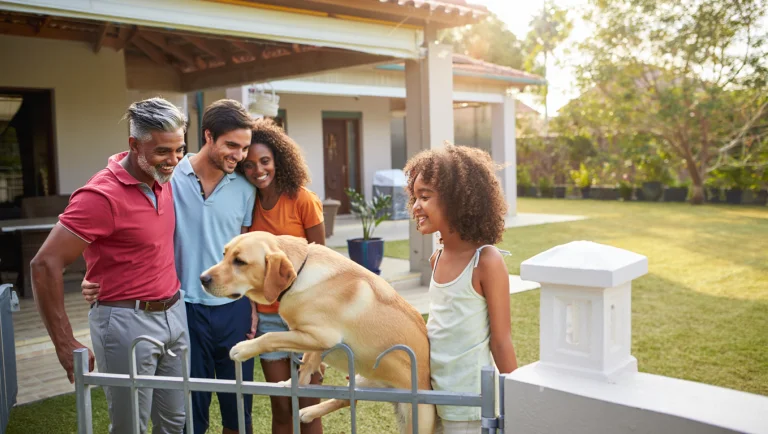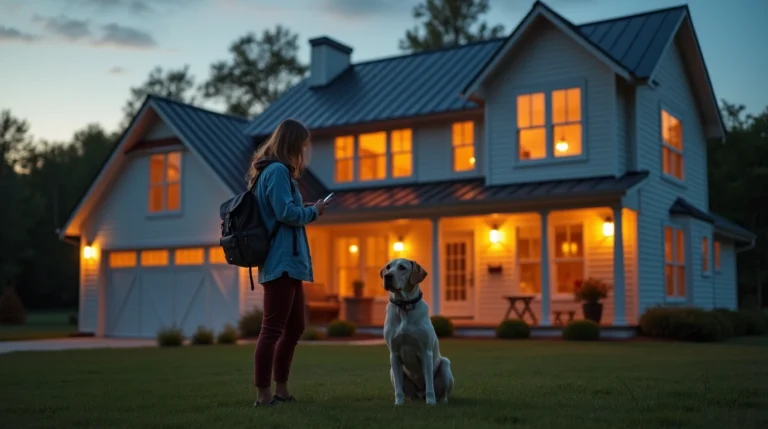Discover 10 effective strategies for finding houses for rent near me pet friendly, plus expert tips on pet deposits, landlord negotiations, and creating a pet-friendly home environment.

Table of Contents
Finding a rental home that welcomes your furry, feathered, or scaled family members can be challenging. According to the American Pet Products Association, approximately 70% of U.S. households own a pet, yet many landlords still hesitate to open their doors to animal companions. This comprehensive guide explores the best options for pet friendly houses for rent, strategies for securing your ideal home, and tips for responsible pet ownership while renting.
Understanding the Pet Friendly Rental Landscape
The rental market for pet owners has evolved significantly in recent years. Property managers and landlords increasingly recognize that pet-friendly policies can attract responsible, long-term tenants. However, navigating this landscape requires understanding the various types of pet-friendly rental arrangements available.
Types of Pet-Friendly Rental Homes
When searching for houses for rent near me pet friendly, you’ll encounter several categories:
1. Fully Pet-Friendly Properties
These rentals welcome pets with minimal restrictions. They typically feature:
- Fenced yards for dogs
- Pet doors (in some cases)
- Durable, pet-resistant flooring
- Nearby walking trails or dog parks
- Few or no breed restrictions
These properties are ideal for multi-pet households or those with larger breeds. They often command higher rent and pet deposits but provide the greatest freedom for pet owners.
2. Pet-Tolerant Properties
These rentals accept pets with more limitations:
- Weight and size restrictions (often under 25-30 pounds)
- Breed restrictions (commonly excluding certain dog breeds)
- Limits on number of pets (typically 1-2)
- Additional pet fees or monthly pet rent
While more abundant than fully pet-friendly options, these properties require careful review of pet policies before signing a lease.
3. Conditionally Pet-Friendly Properties
Some landlords consider pets on a case-by-case basis:
- May require pet interviews or “meet and greets”
- Often request references from previous landlords regarding pet behavior
- Might request pet training certificates
- Could require increased security deposits
These properties offer opportunities to demonstrate your pet’s good behavior and your responsibility as an owner.

10 Ways to Find Pet Friendly Houses for Rent Near Me
1. Specialized Rental Websites and Filters
Most major rental platforms now include “pet-friendly” filters, but some specialize in connecting pet owners with suitable properties:
- Apartments.com – Features robust pet policy filters
- Zillow – Allows filtering by “Allows pets” and “Dogs allowed” or “Cats allowed”
- Trulia – Provides pet-friendly search options
- PetFriendlyRenter.com – Specializes in pet-friendly housing
- Rent.com – Offers detailed pet policy information
When using these platforms, search specifically for “houses for rent near me pet friendly” and set your location parameters to find the most relevant listings.
2. Work with Pet-Friendly Real Estate Agents
Many real estate agents specialize in helping pet owners find suitable rentals. These professionals:
- Have established relationships with pet-friendly landlords
- Know which management companies have favorable pet policies
- Can negotiate pet terms on your behalf
- Save you time by pre-screening properties
- May have access to listings not yet on public websites
Ask potential agents about their experience helping pet owners before engaging their services.
3. Connect with Local Pet Communities
Fellow pet owners can be invaluable resources:
- Join local pet owner Facebook groups
- Attend dog park events and network
- Connect with breed-specific rescue organizations
- Ask for recommendations at pet supply stores
- Engage with veterinary office bulletin boards
These communities often share information about pet-friendly landlords and upcoming rental opportunities.

4. Direct Outreach to Property Management Companies
Larger property management companies often have standardized pet policies across multiple properties:
- Call companies directly to inquire about pet policies
- Request to be notified when pet-friendly units become available
- Ask about any upcoming policy changes
- Inquire about multiple properties they manage simultaneously
This approach is particularly effective in competitive rental markets where listings move quickly.
5. Consider Private Landlords
Individual homeowners may offer more flexibility than corporate property managers:
- Search Craigslist and Facebook Marketplace for “by owner” listings
- Drive through desirable neighborhoods looking for “For Rent” signs
- Network in community groups to find private rental opportunities
- Be prepared to negotiate pet terms directly
With private landlords, personal connections and first impressions matter significantly.
6. Leverage Pet References and Resumes
Creating a “pet resume” can significantly improve your chances of securing a rental:
- Include vaccination records and medical history
- Attach training certificates or behavioral assessments
- Provide references from previous landlords or neighbors
- Include photos of your well-maintained current living situation
- Share information about your pet’s routine and care schedule
This professional approach demonstrates your commitment to responsible pet ownership.


7. Explore Emerging Pet-Friendly Communities
Some newer housing developments specifically cater to pet owners:
- Communities with built-in dog parks and walking trails
- Developments offering pet-sitting services
- Properties with dog washing stations
- Neighborhoods organizing regular pet-focused events
- Housing complexes with veterinary services on-site or nearby
These communities often charge premium rents but provide exceptional amenities for pets.
8. Consider Single-Family Homes Over Multi-Unit Buildings
Single-family houses typically offer advantages for pet owners:
- Private yards for exercise and bathroom breaks
- Greater distance between neighbors (reducing noise concerns)
- Fewer shared walls to transmit barking or movement sounds
- More space for pet furniture and play areas
- Often fewer restrictions on size or number of pets
While potentially more expensive, the benefits for both pets and owners can justify the cost.
9. Explore Short-Term Rentals for Flexibility
If you’re struggling to find a suitable long-term rental, consider:
- Month-to-month rental agreements
- Vacation properties during off-season periods
- Extended-stay hotels with pet-friendly policies
- Corporate housing options that welcome pets
- House-sitting opportunities for pet owners
These temporary solutions can provide housing while you continue searching for permanent options.
10. Negotiate Pet Terms in Non-Pet-Friendly Properties
Some landlords with “no pets” policies may reconsider for:
- Exceptionally well-trained pets
- Higher security deposits
- Additional monthly pet rent
- Pet liability insurance coverage
- Agreement to professional cleaning upon move-out
Approaching these negotiations professionally and respectfully is essential.


Navigating Pet Fees and Deposits
Understanding the financial aspects of pet-friendly rentals helps avoid surprises:
Common Pet-Related Fees
- Pet deposits: Typically $200-500 per pet, sometimes partially refundable
- Pet fees: One-time non-refundable charges, usually $100-300
- Pet rent: Monthly additional charges, typically $25-50 per pet
- Pet cleaning fees: Either upfront or deducted from security deposit upon move-out
- Pet liability insurance: Some landlords require coverage for potential pet damages
Questions to Ask About Pet Fees
Before signing a lease, clarify:
- Which fees are refundable versus non-refundable?
- Are there different fee structures for different types/sizes of pets?
- Does the property offer multi-pet discounts?
- What damages does the pet deposit specifically cover?
- Are there options to reduce fees with pet credentials (training certificates, etc.)?
Having these discussions upfront prevents misunderstandings later.
Making Your Rental Pet-Friendly: Practical Tips
Once you’ve secured a pet-friendly house, consider these strategies to maintain a positive living environment:
Indoor Adaptations for Pet Comfort
- Install temporary pet gates to create safe zones
- Use furniture covers to protect rental property items
- Apply clear vinyl corner protectors to prevent scratching damage
- Place washable rugs over carpeted areas for accident-prone pets
- Use pet-friendly, rental-safe wall hooks for leashes and accessories
Outdoor Considerations
- Check fence integrity before allowing pets unsupervised access
- Consider temporary fencing solutions if needed (with landlord approval)
- Create designated bathroom areas to prevent lawn damage
- Install temporary sunshades for hot climates
- Establish a routine cleaning schedule for outdoor areas
Neighborhood Integration
- Research local leash laws and pet ordinances
- Locate nearest emergency veterinary services
- Identify pet-friendly parks and walking trails
- Connect with neighbor pet owners for support network
- Find nearby pet service providers (groomers, sitters, etc.)
Pet Etiquette for Renters: Maintaining Good Relationships
Following these best practices helps maintain positive landlord relationships:
- Address any damage immediately and transparently
- Keep all required vaccinations current
- Respond promptly to any pet-related complaints
- Follow all agreed-upon restrictions regarding pet areas
- Provide advance notice if adding pets (if permitted)
- Consider soundproofing measures for noisy pets
- Maintain meticulous cleanliness in shared spaces
- Keep pets properly groomed to minimize shedding and odors
- Schedule regular professional carpet and upholstery cleaning
Beyond Dogs and Cats: Considerations for Other Pets
Pet-friendly housing discussions often center on dogs and cats, but other pets require consideration too:
Birds
- Check for restrictions on cage placement
- Discuss potential noise concerns upfront
- Consider soundproofing options for vocal species
- Address potential allergen concerns from feather dust
Fish and Aquariums
- Verify weight restrictions for larger tanks
- Discuss water damage liability
- Consider placement to prevent floor damage
- Address electrical needs for filtration systems
Small Mammals and Reptiles
- Clarify whether these animals count toward pet limits
- Address potential odor management
- Discuss cage placement restrictions
- Clarify policies on escaped pet liability
Outdoor Animals
- Determine whether lease permits outdoor enclosures
- Discuss policies regarding outdoor food storage
- Address pest attraction concerns
- Clarify rules about livestock-adjacent animals (chickens, etc.)
Legal Considerations: Know Your Rights
Understanding legal protections helps navigate the rental process:
Service Animals and Emotional Support Animals
- Service animals are not legally considered “pets” under the Fair Housing Act
- Landlords cannot charge pet fees or deposits for legitimate service animals
- Documentation requirements vary for emotional support animals
- State and local laws may provide additional protections
- Misrepresenting a pet as a service animal carries legal penalties
Local Pet Protection Laws
Some municipalities have enacted “pet-friendly housing” legislation:
- Limiting pet deposit amounts
- Restricting breed discrimination
- Requiring reasonable accommodation for pets
- Establishing pet owner rights
- Providing mediation services for pet-related disputes
Research your local regulations before beginning your housing search.
Recommended Pet Products on Amazon
To make your rental home more pet-friendly and minimize potential damage, consider these products:
- BISSELL Pet Hair Eraser Turbo Rewind Vacuum Cleaner – Keeps floors and furniture free of pet hair
- Nature’s Miracle Advanced Stain and Odor Eliminator – Enzyme-based cleaner for accidents
- IRIS USA Pet Playpen with Door – Configurable containment system for inside or outside
- PetSafe SSSCAT Spray Pet Deterrent – Motion-activated training aid to keep pets from restricted areas
Frequently Asked Questions
How can I improve my chances of getting approved for a pet-friendly rental?
Create a comprehensive pet resume including vaccination records, training certificates, references from previous landlords, and photos. Offer to schedule a “meet and greet” with your pet, and consider offering additional security deposit to demonstrate responsibility.
What breeds are commonly restricted in rental properties?
While restrictions vary widely, commonly restricted dog breeds include Pit Bulls, Rottweilers, German Shepherds, Dobermans, and Chow Chows. Some properties also restrict Huskies, Great Danes, and other large breeds. These restrictions often stem from insurance policy limitations rather than landlord preferences.
Can a landlord change pet policies mid-lease?
Generally, landlords cannot change pet policies during an active lease term if your pet was initially approved. However, they may implement new policies at lease renewal. Review your lease carefully for clauses regarding policy changes and pets.
What’s the difference between “pet-friendly” and “pets considered”?
“Pet-friendly” typically means the property accepts pets meeting certain criteria without additional approval. “Pets considered” indicates the landlord evaluates each pet individually, often requiring interviews, additional documentation, or special approval processes.
How can I dispute an unfair pet damage charge when moving out?
Document your rental’s condition thoroughly before moving in and again when moving out. If charged unfairly, provide before/after photos, cleaning receipts, and written evidence of the property’s condition. Consider requesting third-party assessment if significant amounts are disputed.
Are there tax deductions available for pet deposits or fees?
Generally, pet deposits and fees aren’t tax-deductible for personal residences. However, if you work from home or your pet qualifies as a business expense (therapy animal, guard dog for business), consult a tax professional about potential deductions.
How do I handle neighbor complaints about my pet?
Address complaints promptly and professionally. Implement solutions like additional training, schedule adjustments, soundproofing, or exercise modifications. Maintain open communication with both neighbors and property management. Document your responsive actions.
Expert Pet Care Tips
For more comprehensive information about caring for your pets in rental housing, including specialized training techniques, legal resources for pet owners, and detailed guides for pet-proofing rental properties, visit BlithePet for expert recommendations tailored to your specific situation.
Conclusion Friendly Houses for Rent Near Me
Finding houses for rent near me pet friendly requires persistence, preparation, and flexibility. By understanding the rental landscape, preparing comprehensive pet documentation, and demonstrating responsible ownership, you significantly improve your chances of securing the perfect home for your entire family—including those with paws, claws, scales, or feathers.
Remember that the relationship between tenant, landlord, and pet is built on mutual respect and clear communication. By exceeding expectations as a responsible pet owner, you not only secure your current housing but also help improve rental opportunities for other pet owners in the future.
What challenges have you faced finding pet-friendly housing? Share your experiences and tips in the comments below to help fellow pet owners navigate their housing search.







